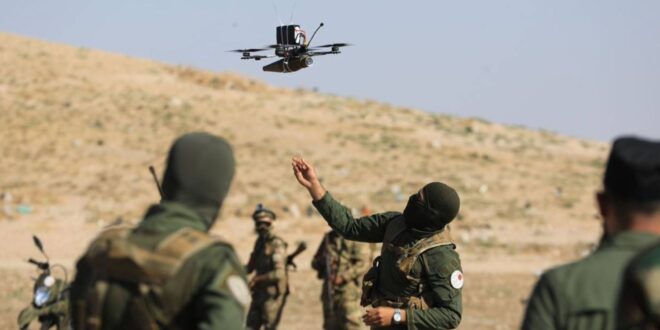On August 20, 2024, the first documented use of suicide drones by factions of the Syrian National Army was observed, Enab Baladi writes.
Drones have evolved significantly from being approved tools for surveillance and reconnaissance in the last two decades of the 20th century to becoming versatile weapons used in air-to-ground and air-to-air strikes. Eventually, they transformed into suicide drones (kamikaze).
Various armies and militias operating on Syrian territory have employed drones in a wide range of roles and missions. However, this technology remained largely inaccessible to opposition forces, aside from some factions’ attempts to create makeshift versions or utilize commercial drones for surveillance.
On August 20, 2024, the first documented use of suicide drones by factions of the Turkey-backed Syrian National Army (SNA) was observed during a training exercise. This project was filmed by the Syrian Interim Government’s Ministry of Defense and involved the 105th Bayrak al-Nasr Unit of the Sultan Murad Division, one of the closest SNA factions to Turkey.
What kind of drones do opposition factions have?
Enab Baladi reached out to the National Army and the Ministry of Defense to inquire about the types of drones in their arsenal, but no information was provided due to the sensitivity of the subject.
Confidential sources within the National Army told Enab Baladi that the army has locally manufactured or modified drones for various combat missions, including ammunition delivery, reconnaissance, and suicide operations. These drones are being prepared for potential military engagements.
Ali Mohamed, a Syrian researcher specializing in drone technology, informed Enab Baladi that the National Army possesses some drones, but these are primarily amateur quadcopters used for short-range reconnaissance and light bombing.
The National Army controls large parts of the northern and western countryside of Aleppo (the Euphrates Shield and Olive Branch areas of operation), as well as the cities of Tal Abyad, north of Raqqa, and Ras al-Ain, northwest of Hassakeh (the Peace Spring area of operations).
Limited impact on military operations
Nawar Shaaban, a researcher at the Omran Center for Strategic Studies, told Enab Baladi that modified suicide drones—commercial models with added shells—make little impact in battles against the Syrian Democratic Forces (SDF) and the regime.
Shaaban explained that these drones are neither offensive nor defensive weapons but are instead used for sabotage, distraction, and jamming. They do not contribute to significant military gains unless deployed in large numbers (20 to 30 drones) along a specific engagement line.
When multiple suicide drones target one or several points on a single axis, they can force those points to relocate, potentially disrupting defensive lines and causing them to retreat, change positions, or abandon high ground.
According to Shaaban, these modified commercial drones offer the capability to strike distant targets without putting the attacker at risk. They are likely to be used to hit targets two to three kilometers deep. However, the success rate is only about 50% because these drones are equipped with larger batteries relative to their size, which increases their speed, making them difficult to control and easy to shoot down.
Fatah al-Mubin acceleration in industrialization
Since 2012, the factions of the Free Syrian Army and various Islamist groups have been working on local military production, achieving some progress despite many challenges.
However, over the years, as the opposition’s control became limited to northwestern Syria, the National Army’s interest in industrialization has waned, especially when compared to the efforts of the Fatah al-Mubin operations room.
Fatah al-Mubin includes factions of the former Free Syrian Army, various Islamist factions, and is led by Hay’at Tahrir al-Sham, the largest group in the coalition.
Operating in Idlib, parts of western Aleppo countryside, eastern Lattakia, and northern Hama, the Fatah al-Mubin operations room utilizes commercial surveillance and reconnaissance drones and has made notable efforts to manufacture drones locally.
In response to Enab Baladi’s question about the state of drone manufacturing between the National Army and Fatah al-Mubin, researcher Ali Mohamed noted that Fatah al-Mubin has shown clear interest and progress in drone development. This progress is driven by local initiatives and creativity in utilizing available resources.
On the other hand, the National Army lacks initiative in this area, despite having the necessary materials. This weakness in adapting to the growing threats posed by hostile drones could be due to a lack of political or organizational will, or because factions are focused on other priorities.
The failure to capitalize on the National Army’s resources for drone manufacturing represents a missed opportunity to enhance both defensive and offensive capabilities. This may stem from a lack of expertise or a clear strategy for developing this field.
The National Army’s reliance on imported or smuggled drones might indicate a lack of confidence or capability in developing domestic drones, making it less flexible and more susceptible to external pressures, according to Mohamed.
Meanwhile, the factions within Fatah al-Mubin have managed to manufacture drones for both reconnaissance and offensive purposes, despite facing technical and material challenges.
They have successfully leveraged locally available resources, such as commercial spare parts and raw materials, to develop multi-tasking drones. This reflects the operations room’s ability to overcome logistical and supply constraints. Developing these drones requires advanced technical knowledge, which Fatah al-Mubin seems to acquire through collaboration with local experts or by gaining knowledge from external sources. According to researcher Ali Mohamed, this ability to learn and adapt is a significant advantage.
 Eurasia Press & News
Eurasia Press & News




